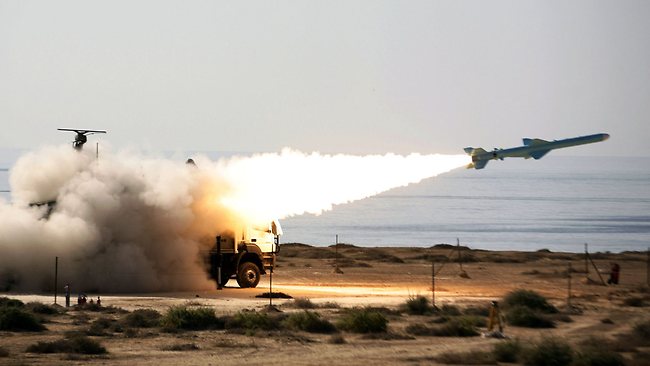Note: This is part two of a series of articles on Iran’s developing military capabilities.
In addition to the ballistic and quasi-ballistic missiles discussed in the previous article, Iran has been further developing its numerous battlefield rockets by improving their accuracy and increasing their range. In 2014, Iran has unveiled no fewer than three new variants of existing ballistic rockets with improved accuracy.

One variant is a version of the Zelzal-3 unguided ballistic rocket with a cluster/submunition warhead, a development that can help minimize the inaccuracy of that unguided rocket system. It should be noted that the Zelzal-3 is the forefather of the guided Fateh-110 short-range ballistic missile. Iran also introduced a new, apparently more accurate variant of the Naze’at heavy rocket with what appears to be a separating warhead. Even smaller rockets, such as the Fajr-5, are being developed into guided rockets, making them ‘missiles.’ Other than the aforementioned systems, Iran has developed a number of variants of a number of rockets, ranging from the 107mm light rocket system, the ubiquitous 122mm Arash (Grad) rocket system, the Falaq series, and the multi-calibre Naze’at heavy rocket. Finally, Iran appears to be developing new launchers for battlefield rockets that enable more rapid reloading.
While most of these rockets are likely intended for use by Iranian proxies such as Hezbollah against Israel, they do reflect an Iranian attempt to increase the accuracy of its rocket forces for tactical and operational level battlefield use that will increase Iran’s own capabilities. For example, a rocket like the Zelzal-3 can be used to saturate the missile defences of nearby targets, thereby increasing the effectiveness of the larger ballistic missiles should the latter be used in follow-up strikes.
In addition to ballistic missiles and battlefield rockets, Iran has also been quietly developing its land attack cruise missile (LACM) capability. A LACM, and a cruise missile more generally, is unlike a ballistic missile. While a ballistic missile is best described as what would be recognized as a large rocket, a cruise missile is a small unmanned plane. The best known of the two are the V-2 and the V-1 produced and used by Nazi Germany during the Second World War. The former was the first operational ballistic missile, the latter, euphemistically called the ‘buzz-bomb’, was the first operational cruise missile.
The status of Iran’s land-attack cruise missile program is unclear. Ukraine illegally exported a small number of Soviet KH-55 LACMs to Iran and China in 2001. Since that date, China has developed a number of LACMs. While Iran has long been assumed to be working on reverse engineering the KH-55 for its own use, potentially with Chinese aid or even in conjunction with China, it has never revealed any such system. Iran has long remained quiet on the issue of LACMs, but in 2012 a senior Iranian officer told Iranian news media that a LACM, the Meshkat, with a range of 2,000km would be unveiled. While that unveiling appears to have been cancelled given that no further details or images were provided, Western intelligence agencies have taken the announcement seriously.
The Meshkat’s cited range is similar to the KH-55 and equivalent to the Shahab-3, Ghadr, and Sejjil ballistic missiles, making it capable of striking targets as far as Israel. Such a system would add a more potent threat to Iran’s adversaries given that cruise missile defence is still in its infancy compared to maturing ballistic missile defence systems. It should be noted, however, that the Meshkat could have a different origin and be unrelated to the KH-55. But given that Iran almost certainly obtained KH-55s, it is unlikely that it would develop a missile very different from the KH-55. In 2014, Iranian media published photographs of an additional LACM on display at an exhibition and the missile was discussed by an Iranian officer in a recent interview. This LACM, the Ya Ali missile is believed to have a range of approximately 700km, making it a LACM compliment to the Qiam-1 ballistic missile.

Iran has long been suspected of attempting to modify anti-ship cruise missiles into land-attack cruise missiles. While a simple conversion in theory, the technical differences in terms of guidance and structural design make the design requirements for each system quite different. In the late 1980s, Iran acquired significant numbers of Chinese made HY-2 Silkworm anti-ship missiles. In the mid 2000s, it tested the Ra’ad anti-ship missile, a greatly modified and upgraded Silkworm. The Ra’ad is reported to have a range of 360km, making it the first cruise missile in Iran’s inventory capable of reaching targets on the other shore of the Gulf. As such, the Ra’ad is a prime candidate for Iran’s first LACM, but there has been no confirmation of this. Moreover, Iran would have experienced technical difficulties utilizing a LACM version of the Ra’ad for anything but the targeting of coastal facilities.
Iran’s recent unveiling of a 300km range anti-ship cruise missile, the Qader, may be modified into an additional LACM, albeit one likely limited to attacking coastal targets due to technical differences between a LACM and a anti-ship cruise missiles. Nevertheless, such a missile would allow Iran to compliment its three tiers of ballistic missile with three tiers of land-attack cruise missiles. (ranged at ~2000km for targets as far as Israel and targets in Iran’s larger neighbours, ~700km for targets deep inside bordering countries, and ~300km for coastal targets in the Gulf and Caspian countries).
Part III will focus on the modernization of Iran’s air defences.




